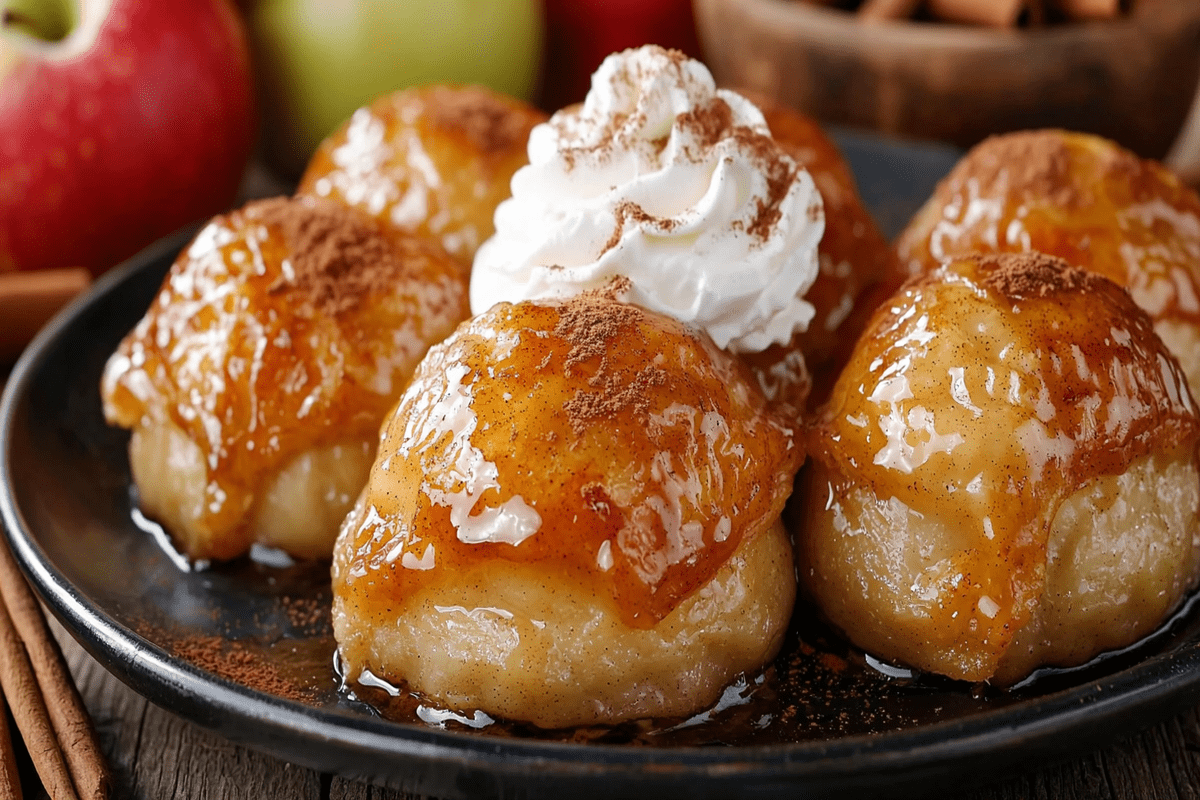Apple dumplings are a cherished pastry dessert enjoyed in different cultures. They are often associated with comforting, home-cooked meals. But what exactly is an apple dumpling, and why has it remained popular for centuries? This article explores the rich history, preparation, cultural significance, and variations of apple dumplings, providing a comprehensive understanding of this delightful dish.
What is an Apple Dumpling?
An apple dumpling is a pastry-wrapped apple that can be either baked or boiled. To make this dish, you peel and core apples, sometimes quarter them, and place them on a portion of dough. You can fill the hollow left by the apple core with ingredients like butter, sugar, cinnamon, and occasionally dried fruits like raisins or currants. After that, you fold the dough over the apples and seal it. In some variations, you pour a spiced sauce over the dumplings before cooking. You can enjoy apple dumplings hot, cold, or at room temperature, and serve them as a breakfast item, dessert, or even a main dish. Discover more about the ingredients used in apple dumplings to understand what makes this dessert so unique.
History of Apple Dumplings
The history of apple dumplings stretches back centuries. Records show they were popular across Europe, particularly in England, as early as the 18th century. Historical texts, such as the writings of Pehr Kalm, mention their prevalence during his travels from New Jersey to Quebec in 1749-1750. These pastries also connect to American settlers who brought their recipes from Europe.
By the 19th century, apple dumplings had become a staple in American cuisine, especially in regions like Pennsylvania, where they played a significant role in Pennsylvania Dutch culture. For instance, country apple dumplings represent a beloved variation that generations have passed down.
Ingredients and Preparation Methods
To make an apple dumpling, gather the following ingredients:
- Apples (peeled and cored)
- Pastry dough (shortcrust or suet pastry, depending on the recipe)
- Butter, sugar, and cinnamon for filling
- Optional: dried fruits like raisins or currants
- Spiced sauce (made from sugar, water, and spices like cinnamon or lemon)
Preparation Methods
- Baking: To bake, wrap the apple in pastry, seal it, and bake it in the oven. You can pour a spiced sauce over the dumplings before baking to enhance their flavor.
- Boiling: Older recipes, particularly those from the 18th and 19th centuries, suggest boiling the dumplings. This method involves wrapping the dumplings in cloth and boiling them, creating a unique texture. Traditional British recipes often use suet pastry for this method.
Serving Suggestions and Variations
There are various ways to serve apple dumplings:
- Hot or Warm: Serve with cream, whipped cream, custard, or ice cream.
- Room Temperature: Ideal for breakfast or a light snack.
- Cold: Enjoy with milk or as a side dish for other desserts.
Regional Variations
Different countries have unique versions of apple dumplings:
- Austria: Known as Apfelnockerln, a large, soft dumpling variation.
- Czech Republic: Called ovocné knedlíky, a fruit dumpling filled with apples and served with quark cheese.
- Germany: The Apfelklöße is a small pudding of apples, often filled with jam or marmalade.
- United Kingdom: In the UK, cooks often use suet pastry and boil the dumplings rather than bake them.
- United States: Apple dumplings are a cultural staple in Pennsylvania Dutch cuisine and are often served with cream or ice cream.
Related Dishes and Similar Recipes
Other dishes resemble apple dumplings, such as:
- Plum Dumplings: Found in Austria, Hungary, and Slovenia, these dumplings use different types of fruit, like plums.
- Baked Apples: Similar to baked apple dumplings but without the pastry shell. The apples are cored and stuffed with fillings like raisins, nuts, or oatmeal.
Nutritional Information and Dietary Considerations
Apple dumplings, while delicious, can be calorie-dense due to their pastry and sugar content. However, they also provide nutritional benefits from the apples, such as fiber and vitamin C. To make them healthier:
- Use whole wheat or gluten-free flour for the pastry.
- Reduce the sugar content or use natural sweeteners like honey or maple syrup.
- Add more fruits or nuts for extra nutrients.
To find out more about the nutritional content, such as the carbohydrate count, refer to this guide.
Apple Dumplings in Popular Culture
Apple dumplings feature in various cultural references, including literature, films, and festivals. In the United States, September 17 marks National Apple Dumpling Day, with festivals in towns like Atwood, Illinois, and Stuart, Virginia. Apple dumplings also frequently appear in local bakeries and diners, especially in the northeastern United States, highlighting their status as a beloved comfort food.
FAQs: Frequently Asked Questions About Apple Dumplings
- What are apple dumplings made of?
Apple dumplings consist of apples, dough, butter, sugar, cinnamon, and sometimes dried fruits. - How are apple dumplings prepared?
You can either bake or boil them, depending on the recipe. - Can apple dumplings be made with different fruits?
Yes, you can make similar dumplings with plums, apricots, or other fruits. - Are apple dumplings healthy?
Healthier versions include whole-grain flour, reduced sugar, and added nuts or other fruits. - What is the origin of apple dumplings?
Apple dumplings originated in Europe and became popular in the United States, particularly within Pennsylvania Dutch cuisine.
Conclusion
Apple dumplings are more than just a dessert; they represent a culinary tradition rich in history and culture. From their beginnings in European kitchens to becoming an American staple, apple dumplings offer a delightful way to enjoy the simple yet versatile apple. Whether baked or boiled, served hot or cold, apple dumplings continue to be a beloved dish worldwide, known for their comforting taste and nostalgic charm.
Enjoy the experience of making and tasting apple dumplings, and discover why this dish has stood the test of time!

